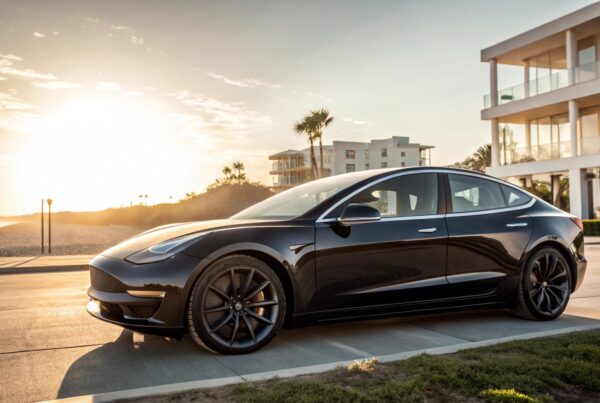Sometimes fashion and style trumps function and practicality. Such is the case with today’s automotive window tint market. With so many types, brands, and VLTs (we’ll explain that term below) on the market, choosing the right window film for your car can be time consuming and frustrating. Kicking off the list of tints for cars is the dyed window tint – and entry level or value-based film that essentially offers one perk – make your windows dark.
So – what is dyed window tint? How is this auto tint film made? Is it comparable to hybrid, metallicized, or ceramic window films? Let’s take some time to explore the facts about window tint that is dyed, so you can determine if a dyed film is good enough for your car.
How is Dyed Window Tint Made?
The majority of car, truck, and SUV owners choose aftermarket window tint film to improve the exterior appearance of their ride. If this is your only goal – and you’re not concerned about longevity or warranties, a high-quality dyed tint installed on a car window by a professional installer is an affordable option.
As the name implies, a dyed window tint is essentially a film that has been treated or coated with a dye to create a darkness a customer prefers or what is legal in their state. The darkness or shade is known as the VLT or Visible Light Transmission percentage – or how much light can pass through the tint once it’s been installed on a window.
VLT percentages can be very confusing for novice car enthusiasts – as you’d think that the higher the VLT % – the darker the tint. Actually – it’s the opposite – the lower the VLT percentage, the less light passes through – and thus – the darker it appears.
Can You Have Colored Window Tint?
Certainly. In fact, most colored window films are simply dyed a specific color. Automotive window film can be made in virtually any color – with charcoal, black, gray, bronze, and gold being the most popular. Many US states outlaw red, blue, and amber colors of automotive window tint – but it is important to check with your state or providence to determine which colored window films are legal.
You can visit this website to review tint laws in each US State.
Does Dyed Window Tint Help Reduce Heat?
A high-quality window tint should deliver three major consumer benefits:
- Provide added privacy from outside viewers into the vehicle.
- Block 99.9 percent of UV rays – including UVA and UVB, which leads to skin and interior material damage.
- Reduce the emissions of infrared radiation (IR) – which is the sun rays that cause heat.
Unfortunately, most dyed window tints only check one of the boxes above. While there are several grades of window films that are dyed on the market, most focus on privacy or adding darkness to the window applied. There are a few that block 99% of UV rays, but those attributes are often reserved to the higher-end grades – sometimes referred to as color stable dyed films.
How Does Dyed Window Tint Compare to Ceramic Tint?
Your run of the mill dyed window film represents and entry point into window tinting. Ceramic tint is the upper tier of professional tint for vehicles. When you opt for a ceramic window tint, the three major attributes for interior protection and enhanced comfort are achieved.
Here is how dyed window film works.
The traditional entry-level of film that is applied to automotive glass is a dyed window tint. It’s essentially an elevated privacy glass, that is available in multiple opacities (or darkness). The film is comprised of an adhesive layer on the bottom, dyed layer in the middle, and a coating of polyester on the surface.
The adhesive sticks to the window, the dye helps to aid in blocking UV A and UV B rays, while the outside polyester coat reduces the potential of scratching. However, this entry-point of window tint is prone to cracking and does not hold up long.
It also is not good at blocking infrared radiation – which creates heat inside the vehicle. Additionally, with excessive exposure to sunlight, the film tends to turn purple – which reduces visibility. This simply doesn’t occur with a ceramic window tint film.
A ceramic tint or ceramic window film is installed the exact same way. However, nanotechnology infused in the film provides a reflective shield that can reduce heat, nearly eliminate harmful UV rays, and keep vehicle occupants safer.
So – if you’re going to compare dyed window tint to a ceramic film, it’s similar with comparing a Nissan Sentra to a BMW M-Series.
Is there a Better Alternative to Dyed Window Tint?
KAVACA Carbon CS is the Ultimate Comfort in dyed window films. Developed with a proprietary formulation of nano-carbon technology to deliver excellent color stability without sacrificing clarity. The heat rejection, glare control and UV protection accomplished through nano-scaled carbon particles is metal-free, supporting signal clarity for all types of electronic devices – unlike a metalized tint.
KAVACA Carbon CS lets you customize your car with any of the 4 shades offered, without a loss in heat rejection with clear VLT’s. KAVACA Carbon film advanced technology offers a non-reflective tinted window, color stable finish that will not fade over time.
The proprietary formulation of KAVACA Carbon Color Stable window tint has the utmost clarity in all carbon tint percentages. This means that from the driver’s seat you can enjoy the privacy and enhanced looks while maintaining the best view of the outside.
The glare control alone enhances your view of the road, while the heat rejection and UV protection increases your comfort and safety. The best part is that all this performance is guaranteed to remain, year in and year out. It’s simply put – the best dyed window tint film available on the market today.
If you’re thinking about investing in a carbon window tint that gives you the flexibility to enhance the visual appeal, blocks up to 99.9% of UV rays, and can likewise reduce interior temperature, a carbon color stable window tint offers more bang for your buck.





